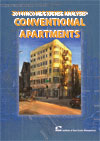
by Brianna Crandall — September 17, 2014—Facilities managers of multifamily rental properties will find valuable information in the latest benchmarking study analyzing income and expenses and key performance trends for conventional apartments just released by the Institute of Real Estate Management (IREM).
Gross possible rents for the four conventional rental apartment types examined (elevator; low-rise with 12 to 24 units; low-rise with 25-plus units; and garden) rose within a range of 0.1% and 4.5% in 2013 versus 2012. Net Operating Income (NOI) for the four apartment types rose between 4.8% and 9.9% from the prior year. Total expenses for two of the four building types experienced year-to-year increases of under 1.5% whereas the other two showed year-to-year decreases of under 5%.
These key findings, reported in the 2014 edition of the Income/Expense Analysis: Conventional Apartments, are drawn from a control sample of conventional apartments that have submitted data for the report consistently over the past four years. The report also contains data drawn from a larger sample of submissions gathered over the past five years, regardless of whether that data was submitted consecutively over the five-year period. In terms of sample size, the report analyzes the previous year’s operating income and cost figures for 3,557 multifamily rental properties representing over 717,000 units across the United States and Canada.
The report is designed to help real estate professionals evaluate multifamily development and investment options and compare their buildings’ performance to industry norms. The publication also is an invaluable resource to build better budgets; identify ways to trim waste, address inefficiencies, and make needed improvements; prepare feasibility studies, appraisals and loan requests; and much more, says IREM.
Other findings drawn from the four-year control sample:
- Net Operating Income (NOI): NOI for low-rise buildings with 12-24 units rose 9.9% to $5.53 per square foot; NOI for low-rise buildings with 25 or more units rose 7.2% to $6.11 per square foot; NOI for elevator buildings rose 5.2% to $10.44 per square foot; and NOI for garden buildings rose 4.8% to $5.50 per square foot.
- Gross possible rents: Low-rise buildings with 25-plus units reported the highest increase, 4.5%, raising the rent per square foot to $11.53. Elevator buildings reported a 3.8% rent increase to $17.70 per square foot; garden buildings reported a 1.7% gain to $11.09 per square foot; and low-rise buildings with 12 to 24 units reported a rent increase of 0.1% to $11.06 per square foot.
- Expenses: Those for elevator buildings rose 0.3% to $7.82 per square foot; expenses for low-rise buildings with 12-24 units declined 4.5% to $5.68 per square foot; those for low-rise buildings with 25 or more units sidelined 1.5% to $5.37 per square foot; and those for garden buildings rose 1.3% to $5.33 per square foot.
- Utility costs: As reported for three of the four building types, elevator buildings remained the most costly, totaling $1.33 per square foot. Garden buildings saw a slight cost rise of 2.6%, increasing to $0.79 per square foot, and low-rise buildings with 25-plus units saw no cost change, remaining at $0 .90 per square foot.
- Maintenance and repair costs: Low-rise buildings with 12-24 units were the highest, rising 12.1% to $1.11 per square foot. Those for elevator buildings increased 12.3% to $0.64 per square foot; those for garden buildings rose 9.1% to $0.36 per square foot; and those for low-rise buildings with 25-plus units rose 5.0% to 0.42 per square foot.
- Operating ratios: Less than 50% of a typical property’s annual collections were used to cover operating expenses. All four building types remained relatively stable with low-rise buildings with 12-24 units experiencing the highest operating ratio at 49.7%, factoring in a 3.1% decline from the prior year. Elevator buildings reported the lowest operating ratio at 42.0%, representing a 1.5% decline from 2012.
Some key findings drawn from the larger sample
- Uncollected income due to vacancy and other forms of rent loss increased slightly for two of the four building types, decreased slightly for one, and stayed the same for the remaining one. At 6.2%, garden buildings have the highest vacancy and rent loss as a percentage of gross possible income, followed by low-rise building with 25-plus units at 5.8%; elevator buildings at 4.9%; and low-rise buildings with 12-14 units at 4.5%.
- An analysis of tenant turnover indicates that low-rise buildings with 12-24 units saw the lowest turnover ratio at 39.4%, up 2.7% from the prior year. Low-rise buildings with 25 or more units reported a turnover ratio of 46.7%, a year-to-year dip of 0.1%, and elevator buildings reported a 43.5% turnover ratio, a 4.0% increase from the prior year. Garden buildings experienced the highest turnover ratio at 49.5%, despite a year-to-year decline of 2.5%.
The IREM Income/Expense Analysis research study summarizes data by building type, age, Section 42 properties, turnover and more, with data presented in dollars per square foot of rentable area and as a percentage of gross possible income and dollars per unit. Individual metro market reports for more than 120 cities also are included along with an analysis of vacancy rates and operating unit trends, plus a variety of historical trend reports.
A state-of-the-art companion product called the Income/Expense Analysis Online Lab consists of an interactive Web site with 24/7 access that enables purchasers to download over 10 years of historical conventional apartment building data — including over 100 customizable line-item variables — and compare it to the operating data in their individual portfolios.
The 320-page Income/Expense Analysis: Office Buildings report is available from IREM’s Income/Expense Analysis Reports Web page in either soft cover or a downloadable format to IREM members and non-members for $242.95 and $484.95, respectively, plus shipping and applicable state sales tax. The page also features new 2014 editions of four other annual Income/Expense Analysis studies, each of which has a companion Lab: Office Buildings; Shopping Centers; Condominiums, Cooperatives and Planned Unit Developments; and Federally Assisted Apartments.





